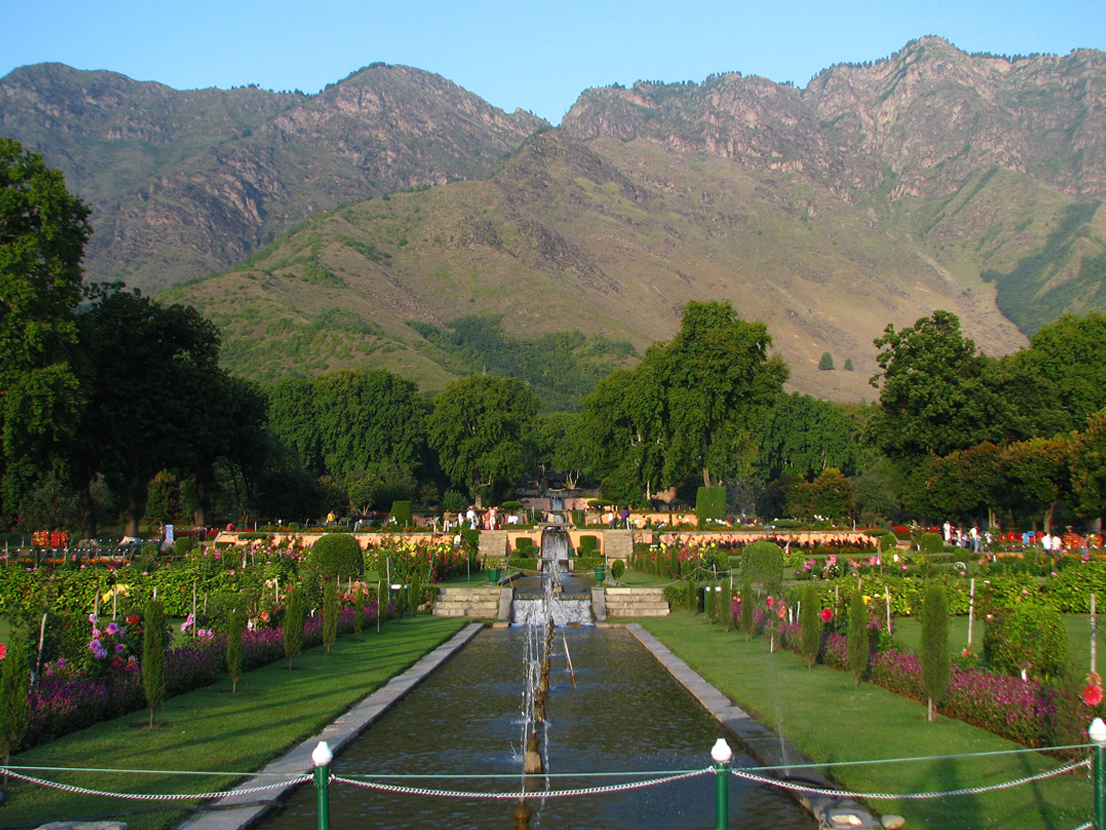Darjeeling: The Queen of the Hills in West Bengal Darjeeling, nestled in the Indian state of West Bengal, is one […]

About the Mughal Gardens, Srinagar
The Mughal Gardens in Srinagar, Jammu and Kashmir, are a spectacular ensemble of terraced gardens that epitomize the grandeur of Mughal landscape architecture. Renowned for their breathtaking beauty and meticulous design, these gardens are a testament to the Mughal emperors’ appreciation of nature and art. With their lush green lawns, cascading water features, and intricate floral arrangements, the Mughal Gardens of Srinagar remain one of the most visited and cherished attractions in the region.
Historical and Cultural Significance
- Historical Background: The Mughal Gardens of Srinagar were built by various Mughal emperors during the 16th and 17th centuries. The most prominent of these gardens were commissioned by Emperor Jahangir, who was enchanted by the natural beauty of Kashmir. The gardens were designed to provide a picturesque retreat for the royal family and were influenced by Persian garden design principles, which emphasize symmetry, water features, and lush greenery.
- Architectural Influence: The design of the Mughal Gardens reflects a fusion of Persian, Central Asian, and Indian styles. The use of terraced levels, water channels, and elaborate floral patterns is characteristic of Persian gardens, while the incorporation of local materials and craftsmanship adds a distinct Indian touch. The gardens are laid out in a rectangular shape with a central water channel, surrounded by rows of trees, flowerbeds, and pavilions.
- Cultural Importance: The Mughal Gardens hold immense cultural significance as symbols of the Mughal era’s artistic and architectural achievements. They are often featured in Kashmiri art, literature, and poetry, representing the region’s rich heritage and the Mughal emperors’ appreciation of natural beauty. The gardens are also a popular destination during the annual Tulip Festival, where the blooming tulips add vibrant colors to the already picturesque landscape.
Major Mughal Gardens in Srinagar
- Shalimar Bagh: Shalimar Bagh is one of the most famous Mughal gardens in Srinagar, known for its grandeur and historical significance. Built by Emperor Jahangir in 1619, the garden is designed in a three-tiered layout with cascading terraces. The upper terrace, known as Farah Baksh, is adorned with beautifully sculpted fountains and water channels. The central terrace, Faiz Baksh, features a large water pool surrounded by lush lawns and flowerbeds. The lower terrace, Shalimar, is characterized by its sprawling garden area and the famous “Shalimar Bagh Chashme Shahi” or royal spring.
- Nishat Bagh: Nishat Bagh, meaning the “Garden of Joy,” was built by Emperor Jahangir’s elder brother, Asif Khan, in 1633. The garden is renowned for its expansive layout and panoramic views of Dal Lake and the surrounding mountains. Nishat Bagh is designed in a seven-tiered terraced layout, with each terrace representing a different aspect of paradise. The garden features a large central water channel, surrounded by meticulously manicured lawns, flowerbeds, and a variety of trees.
- Chashme Shahi: Chashme Shahi, meaning the “Royal Spring,” is the smallest of the three major Mughal gardens but is known for its natural beauty and serene atmosphere. Built by Emperor Shah Jahan in 1632, the garden is named after the natural spring that flows through it. Chashme Shahi is laid out in three terraced levels, with the upper terrace featuring a water fountain and a beautiful view of Dal Lake. The garden is renowned for its floral arrangements and tranquil environment, making it a popular spot for relaxation.
- Pari Mahal: Pari Mahal, or the “Palace of the Fairies,” is an exquisite Mughal garden located on the slopes of the Zabarwan Range overlooking Dal Lake. Built by Dara Shikoh, the eldest son of Emperor Shah Jahan, the garden is an architectural marvel with its terraced layout, water channels, and panoramic views. Pari Mahal is known for its historical significance and its role in Persian garden design.
How to Reach the Mughal Gardens, Srinagar
By Air:
Sheikh ul-Alam International Airport (Srinagar Airport): The nearest airport to the Mughal Gardens is Sheikh ul-Alam International Airport, located about 15 kilometers from the gardens. The airport has regular flights from major cities such as Delhi, Mumbai, and Bengaluru. From the airport, you can hire a taxi or use app-based cab services to reach the gardens.
By Rail:
Udhampur Railway Station: The nearest major railway station is Udhampur, approximately 230 kilometers from Srinagar. Udhampur is well-connected to various cities in India. From Udhampur, you can hire a taxi or take a bus to Srinagar.
By Road:
National Highways: Srinagar is accessible by road through National Highway 44 and National Highway 1A. The drive from Jammu to Srinagar typically takes around 8 to 10 hours. You can hire a taxi or take a bus from Jammu to reach Srinagar.
Local Transportation:
Within Srinagar: Once in Srinagar, local transportation options include taxis, auto-rickshaws, and shikaras. The Mughal Gardens are located around the city and are easily accessible by local transport. Many visitors choose to hire a taxi or a private car to visit multiple gardens in one day.
Conclusion
The Mughal Gardens of Srinagar offer a glimpse into the opulence and artistry of the Mughal era. With their stunning layouts, intricate water features, and vibrant floral displays, these gardens are a testament to the Mughal emperors’ love for nature and aesthetics. Whether you’re exploring the grandeur of Shalimar Bagh, enjoying the expansive beauty of Nishat Bagh, or relaxing in the serene Chashme Shahi, the Mughal Gardens provide a memorable and enriching experience for all visitors. Their historical significance, cultural richness, and natural beauty make them an essential destination for anyone traveling to Srinagar.

